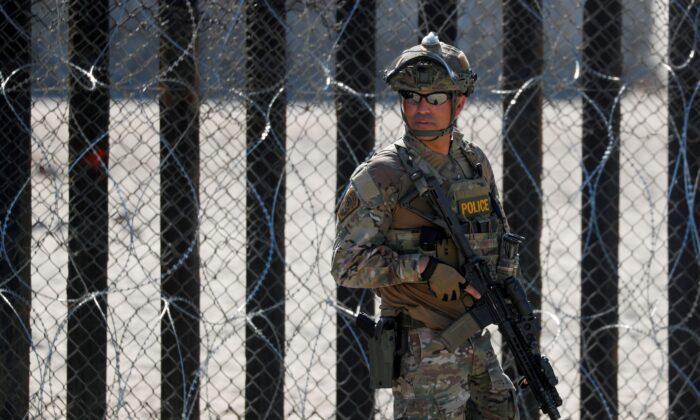Total encounters with illegal immigrants along the Southwest border in June fell to the lowest level in more than two years, dropping nearly a third from the previous month, according to newly released data from U.S. Customs and Border Protection (CPB).
Total encounters, including those who presented at ports of entry with or without a CBP One appointment, were 144,607, marking a 30 percent decrease from the previous month, and represents the lowest monthly number since February 2021.
The agency attributes the decline to enforcing consequences under Title 8 authorities and expanding lawful pathways and processes, it said in a July 18 statement. CBP also reported that its drug interdiction efforts have resulted in a significant increase in narcotics confiscations.
The U.S. Border Patrol recorded 99,545 encounters between ports of entry, representing a 42 percent decrease from May.
Troy A. Miller, CBP senior official performing the duties of the commissioner, credited the agency’s efforts to enforce consequences under Title 8 authorities and the expansion of lawful pathways for the decline in illegal migrant encounters.
“Our sustained efforts to enforce consequences under our longstanding Title 8 authorities, combined with expanding access to lawful pathways and processes, have driven the number of migrant encounters along the Southwest border to their lowest levels in more than two years,” he stated. “We will remain vigilant.”
CBP has made progress in stopping dangerous drugs from being moved across the border, in addition to slowing illegal immigration. The agency has added more nonintrusive scanning tools and put forward working labs in place to quickly find potential drugs and spot trends.
Recent CBP Changes
CBP processes all migrants in accordance with Title 8 immigration laws and places illegal border-crossers into expedited removal or Section 240 removal proceedings.Illegal immigrants who cross between ports of entry or show up at a port of entry without making a CBP One appointment are subject to the “lawful pathways rule,” which states that people can’t get asylum if they don’t use legal methods. There are some exceptions to this rule, though.
In order to disrupt supply chains involved in the development and movement of fentanyl, CBP began two new interagency operations in June: Operations Artemis and Rolling Wave.
Operation Artemis, which began on June 5, has made more than 130 seizures, including 21 pill presses, 54 pill molds, more than 5,000 pounds of precursor chemicals, more than 300 pounds of methamphetamine, and more than 5,000 pounds of other drugs.
Concurrently, the U.S. Border Patrol is running Operation Rolling Wave, which has seized more than 1,500 pounds of fentanyl, more than 1,000 pounds of cocaine, more than 8,000 pounds of marijuana, and more than 6,500 pounds of methamphetamine.
The agency also asserted in its statement that it would continue to enhance technology deployment to improve the traveler experience, while maintaining high security standards. Trade volumes have reportedly rebounded from pandemic lows, and CBP processed more than 3.1 million entry summaries valued at more than $278 billion in June.
CBP has also taken significant measures to protect consumers and eradicate forced labor from supply chains by assisting with the implementation of the Uyghur Forced Labor Prevention Act.
How Statistics Are Reported
One possibility for the stark change could involve how illegal entries are reported after the end of Title 42.During a June 6 hearing of the House Homeland Security Committee’s Border Security and Enforcement Subcommittee, Chairman Clay Higgins (R-La.) stated that immigration officials are changing their method in a way that is “misleading by design.”
Specifically, the administration has redefined some illegal crossings as “those that have entered by legal pathway”; Republicans accuse the administration of aiding and abetting this process through the CBP One app.
The CBP One app permits illegal aliens to schedule an appointment with U.S. officials at the border and obtain entry to the United States based on asylum claims. During the hearing, Republicans were harshly critical of the controversial application, which allows illegal aliens to cross the boundary via a “legal pathway,” as defined by the administration.
“Despite what [Department of Homeland Security Secretary Alejandro Mayorkas] and other officials at DHS are advising the American public regarding the numbers being down, what we’ve come to observe is rather a shell game in the way numbers are documented and reported,” Mr. Higgins said.
He characterized the action as an overreach by the executive branch.





